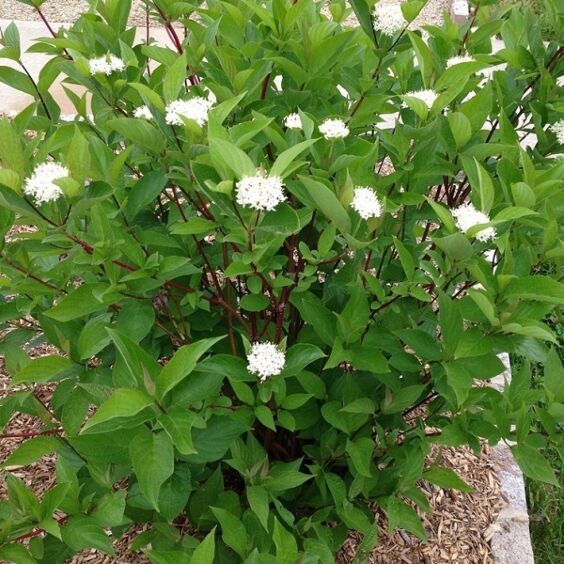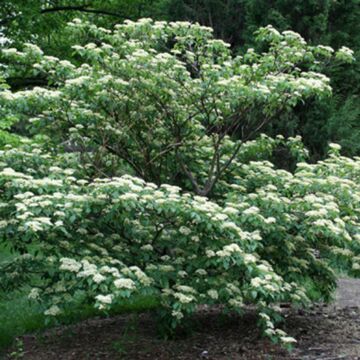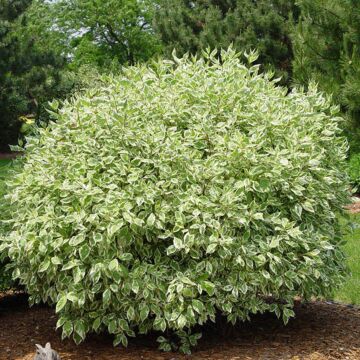
Growing zones
See Zone Map >Status: In stock
Please note: #5 containers cannot be shipped to Arizona, California, Idaho, Montana, Nevada, Oregon, Utah, Washington due to size restrictions.
- Sun, Part Sun/Shade
Mature Plant Size (H x W): 8-10' x 8-10'
Bloom Season: Spring, Summer
- Attracts Birds
- Deer Resistant
- Winter Interest
- Rain Gardens
- Walnut Toxicity Resistant
- Attracts Butterflies
- Cut Flower
- Attracts Pollinators
Planting & Care for Bailey Red-Twigged Dogwood
Preparation
- This shrub will tolerate some shade and moisture.
- Like most Dogwoods, remove old stems in winter for the best stem color by spring.
- Mature growth for this shrub is around 8-10' tall and wide.
- Use this plant in the landscape for erosion control, privacy screens, barriers, or mass planting.
Opening Plant Material
- Bare Root: Cut open the bundle (top and roots are tied) and separate all the plants. Soak roots in buckets of water until planted. Each plant type will be labeled separately for identification. Keep the roots from full sun since they should never dry out. Keep roots covered. All bare-root plants must be trimmed when planted.
- Grow Bags: Remove the bag by using a utility knife to slit up the side and peel off the fabric exposing the soil and roots. Plant the root ball just like you would a container plant. No trimming of roots is necessary for grow bags.
- B&B: Soak root ball well. Dig a hole at least 6" wider and no deeper than the size of the ball on the plant. Rotate the plant to the proper position. Never lift or move trees by the tops.
- Containers: Completely saturate all container plants by putting them in a larger water container until bubbling stops. Remove the plant, then dig a hole no deeper than the depth of the container, ensuring it’s wider on the sides by an additional 6” or more.
Planting Bare Root
- Plant bare root in fall. A good indicator of whether you can still plant is if the ground is still workable. If a hard frost is expected, hold off on planting.
- Dig a hole at least 6" wider and the same depth as the root mass. The crown or graft of the plant should be slightly higher than ground level where it was grown at the nursery.
- Trim off the broken roots and branches.
- Place fertilizer packets in the hole (if purchased). Do not place other fertilizers in the planting hole. *Use Our Recommended Fertilizer.
- Spread the roots and fill halfway with soil, then water until the soil settles completely, saturating the soil and planting pit.
- Re-adjust the plant and fill the hole with the rest of the soil.
- Backfill the balance of the soil and water well.
Planting Grow Bags
- Plant grow bags in spring or fall.
- Notice where the base of the trunk flares out from the tree. This is called the root flare. This root flare should show when the tree is planted. Add soil under the ball so the root flare is exposed if necessary.
- Place fertilizer packets in the hole (if purchased). Do not place other fertilizers in the planting hole. *Use Our Recommended Fertilizer.
- Backfill the hole with soil, ensuring the top of the root ball is visible and slightly higher than the soil around it.
- Firm the soil around the plant. Water well to settle soil around the root ball.
Planting B&B Trees
- Plant B&B trees in spring or fall. A good indicator of whether you can still plant is if the ground is still workable. If a hard frost is expected, hold off on planting.
- Notice where the base of the trunk flares out from the tree. This is called the root flare. This root flare should show when the tree is planted. Add soil under the ball so the root flare is exposed if necessary.
- Place fertilizer packets into the bottom of the hole (if purchased). *Use Our Recommended Fertilizer.
- Backfill ½ of the hole with soil and completely saturate the soil with water.
Once the tree is straight in the proper location, cut and remove twine. Then, remove or bend back the top of the metal basket. Lastly, remove the exposed burlap from the top of the ball. - Fill the hole to the top of the ball with soil, then soak well with water and let settle.
- The top of the root ball should be visible and slightly higher than the soil around it.
- Add mulch on top of the soil, making sure not to put mulch against the trunk or stems.
Planting Containers
- Dig a hole no deeper than the depth of the container and 6" or wider on the sides.
- Slide the plant from the pot by tapping on the bottom of the pot.
- With a shovel or knife, trim the bottom 2" off the root ball for plants in plastic containers.
- Rotate the plant to the proper position. Never lift or move plants by the tops.
Place the root ball in the hole. - Adjust the plant height so the root crown is slightly higher than the ground.
- Notice where the base of the trunk flares out from the tree. This is called the root flare. This root flare should show when the tree is planted. Add soil under the ball so the root flare is exposed if necessary.
- Place fertilizer packets into the bottom of the hole (if purchased). *Use Our Recommended Fertilizer.
- Backfill the hole with soil, ensuring the top of the root ball is visible and slightly higher than the soil around it.
- Firm the soil around the plant. Water well to settle soil around the root ball.
Pruning - After Planting
- Bare Root: Prune ALL bare root plants to reduce transplant shock and ensure successful planting. Pruning should occur as soon as possible, before or after planting, and with sharp pruning shears.
- B&B, Grow Bags, and Containers: Although it’s not essential after planting, light pruning can help shape a Red-Twig Dogwood shrub. Doing so removes any broken branches from shipping or thins out a heavily branched plant to assist in the transplanting process and the appearance of your new planting.
Watering - After Planting
- Plants typically take approximately 6 weeks to establish new roots in your soil. During this period, water plants as often as every 2-4 days at the start and at least a minimum of once per week.
- Beyond the six-week establishment period, water once per week unless rain occurs.
- Remember to check soil moisture by sticking your finger into the soil around 3”.
Watering - Through-out the Season
- After the first season, plants should only be watered during extended periods without rain.
- How do you know if your plants need water? The easiest way to tell is to touch the soil around the roots. If it is moist, there is no need to water. If it’s dry, give it a good soak with the hose end (no nozzle), watering the soil only, not the leaves.
- Same as after planting, stick your finger into the soil around 3” to check soil moisture.
Frequently Asked Questions
What are the recommended companion plants for a Bailey Red-Twig Dogwood?
Bailey Red-Twig Dogwood shrubs pair well with various plants that can complement their vibrant red branches and multi-colored summer foliage. Some excellent choices from McKay Nursery include Hydrangeas for their lush flowers, Hostas for their shade tolerance and foliage variety, and Viburnum for additional structure and flowering. These companions help create a layered, textured garden that highlights the distinctive features of each plant.
Is a Red-Twig Dogwood easy to grow?
A Bailey Red-Twig Dogwood shrub generally requires minimal maintenance but can be prone to some common issues. If the vibrant red color of the stems fades, it often indicates aging stems. Pruning annually, particularly cutting back older stems, can help rejuvenate the plant and restore its bright red color in winter. The plant may also experience stem blight, evident from black spots on the stems; affected branches should be pruned using sanitized tools. Additionally, unwanted suckers might grow and drain energy from the plant; these should be regularly pruned to maintain the shrub's health and appearance.
Are there any specific diseases or pests that target Bailey Red-Twig Dogwood shrubs?
Common diseases that affect Bailey Red-Twigged Dogwood shrubs include powdery mildew and spot anthracnose. Powdery mildew appears as a white coating on leaves, while spot anthracnose shows as small tan spots with purple borders on flower bracts and leaves. For pests, the Dogwood borer is significant, as its larvae can kill trees by burrowing into the bark. Managing these issues involves cultural practices like improving air circulation, using resistant cultivars, and applying fungicides or insecticides as necessary.
How should I prune Bailey Red-Twig Dogwood to maintain its shape and promote healthy growth?
Pruning should be done in late winter or early spring before new growth starts.Remove damaged or diseased branches, thin out older stems, and cut back one-third of the oldest stems to ground level annually to encourage vibrant new stem growth. Doing so is particularly important for maintaining the bright red winter coloration.
How can I prepare my Bailey Red-Twig Dogwood shrubs for winter?
To prepare Bailey Red-Twig Dogwood shrubs for winter, it's important to cut back their branches. Standard pruning can maintain the plant's structure and promote healthy growth for the following season. It's also crucial to apply a layer of mulch around the base to protect the roots from freezing temperatures. This care helps ensure the dogwood remains healthy through the cold months.
Enhance Your Garden With Expertise from McKay Nursery
Here at McKay Nursery, we offer an expertly curated collection of plants, including the eye-catching Bailey Red-Twigged Dogwood. Located in the scenic region of Waterloo, Wisconsin, our nursery is dedicated to growing hardy and vibrant plants for your landscape design.
When you choose us for your gardening needs, you're guaranteed top-quality plants can be supported by our one-year warranty. We take great care in packaging your plants to ensure they arrive in perfect condition, ready to beautify your landscape.
Let us help you bring your garden vision to life, and order your very own Red-Twig Dogwood today! For more information, contact us at [email protected] or call us at 920-478-2121.
Planting & Handling Help
Download our Planting and Handling Guide below to plan for a successful arrival and install of your plants. Be sure to water all plants as soon as they arrive and every day until you’re ready to plant. Keep any bare root bundles in a shady, cool spot with the roots covered at all times.


Learn More
Watch our videos on handling bare root plants, how your order is prepared for shipment and more.


Plant Sizing
What is the difference between Containers, Grow Bags, Bare Root, and Balled & Burlap (B&B)?
Shipping Times


Our FedEx and local shipping times depend on two factors, one is by the region and the second is the type of product being shipped. For example, small fruits are only shipped in spring, but majority of our perennials are shipped from spring until fall. Keep in mind the dates below act as a general guide. Due to unpredictable weather, staffing, inventory and industry demands these timelines can change. Therefore, we cannot guarantee any of these times.
Shipping Dates by Region*
Northern Cold Region: April 22nd - November 7th
Northern Region: April 15th - November 7th
Middle Region: April 1st - November 7th
Southern Region: March 15th - November 7th
Local Delivery (small radius from Waterloo, WI): April 22nd - November 7th
Shipping Dates by Season*
Spring Shipping: Region Start Date (above) - May
Fall Shipping: September - November
Due to unpredictable weather, these times may vary. Some varieties are exceptions due to heat and plant health reasons. Enter your shipping zip code at the top of this page and be sure to check the shipping information on each product before you add it to your cart. If the product is too large or restricted in your state, you will not be able to checkout with that item in your cart.


